A Detailed Outline of the Latest Strategic Energy Plan—
Insights into Japan’s Energy in a Drastically Changing World (Part 2)
(Provisional translation)
(English ver.) 2025-09-01

A wide range of events are unfolding around the world, and the situation regarding energy is changing from moment to moment. Under such circumstances, insights into how Japan’s energy policy is being designed are essential. The Government of Japan formulates the Strategic Energy Plan to express the direction of Japan’s energy policy. On February 18, 2025, the seventh and most recent Strategic Energy Plan was published. Part 1 of this article highlights the challenges Japan is facing in terms of energy as well as policy directions to address them. Part 2 explains policies outlined for the respective fields in relation to energy.
What policies has the Seventh Strategic Energy Plan maintained and changed from the last version?
Based on the broad policy direction of the Seventh Strategic Energy Plan explained in Part 1 of this article, let’s now look at the policies outlined for the respective fields, as follows:
Energy efficiency improvement/shift to non-fossil fuels: While the importance of energy efficiency improvement remains unchanged, shift to non-fossil fuels will be more crucial than ever.
It is essential to achieve an energy supply and demand structure capable of withstanding an energy crisis. To this end, the Plan stresses that improving energy efficiency remains important.
Improving the energy efficiency of semiconductors and developing cutting-edge technologies—such as photoelectric fusion—will contribute to efficiency improvements at data centers. Energy efficiency improvement at factories and homes is also required.
Technologies for developing energy-efficient data centers and semiconductors
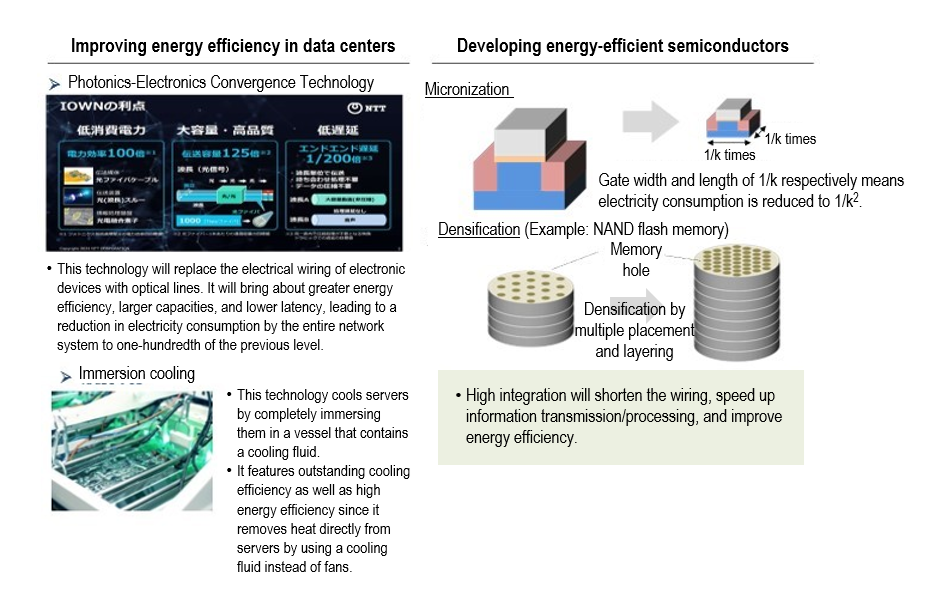
Source: Created by ANRE based on the material presented by Mr. Katsuhiko Kawazoe at the GX2040 Leaders Panel on July 2, 2024, and other information available on the websites of related companies
Furthermore, the electrification of power and heat sources as well as the shift away from CO2-emitting fossil energy, such as oil and coal, will be more important than ever to advance towards decarbonization by 2050.
In fields where electrification is feasible, advancing the decarbonization of power sources together with electrification is required. In industries that are hard to decarbonize due to difficulties in electrification, we will promote a shift to fuels which emit less CO2, such as natural gas. We will also implement measures for the utilization of hydrogen and its derivatives as well as carbon dioxide capture, utilization and storage (CCUS) technology, which separates and captures CO2 and then stores it underground or utilizes it.
Decarbonized power sources: Maximum utilization of decarbonized power sources is essential, instead of having dichotomous discussions on whether to use renewable energy or nuclear power .
As digital transformation (DX) and green transformation (GX) progress, a substantial increase in electricity demand is anticipated.
Data centers and chip factories need to be supplied with electricity at internationally competitive prices and from decarbonized power sources that can be operated in a stable manner.
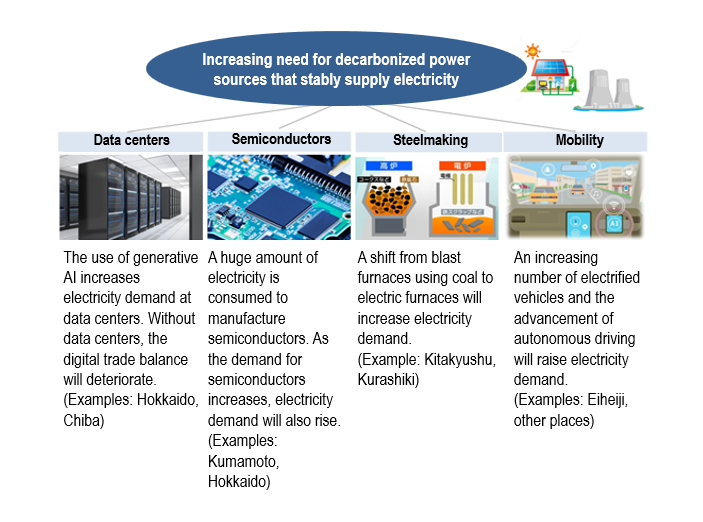
We should stringently ensure no missed opportunities for investment in data centers and chip factories due to the lack of decarbonized power sources, as this would lead to a situation in which Japan’s economic growth and industrial competitiveness would be hampered. Considering these circumstances, the Seventh Strategic Energy Plan stresses the importance of utilizing both renewable energy and nuclear power to the maximum extent possible, instead of dichotomous discussions on whether to use one or the other.
More investment in decarbonized power sources is needed to meet the increase in electricity demand
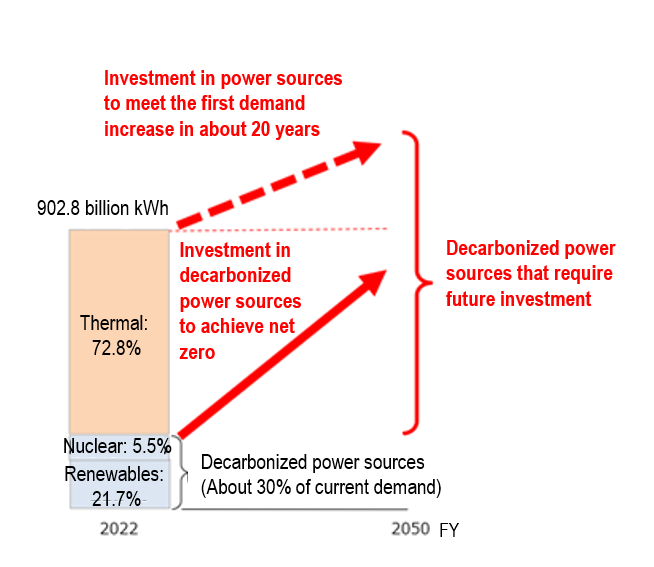
Furthermore, in order to strengthen the supply ability of decarbonized power sources, the Plan stresses that it is necessary to develop a business environment in which businesses are encouraged to make new investments with increased predictability of the return on investment in decarbonized power sources. The Plan also states that efforts will be made to develop a financing environment to secure funds necessary for large-scale, long-term investment in power sources and electricity network development.
Renewable energy: Incorporated to the maximum extent to make it a major power source
Making renewable energy a major power source should be a common objective among related ministries and agencies. Concerted efforts will be made to advance toward the maximum incorporation of renewables while ensuring coexistence with the local communities and curbing the burden on the public.
Promoting the popularization of domestic renewable energy and raising the technology self-sufficiency ratio will contribute to the strengthening of Japan’s industrial competitiveness, not to mention decarbonization.
On the other hand, renewable energy is facing a number of challenges such as coexistence with local communities, reducing public burdens caused by the surcharge on renewables, and the acceleration of innovation. To address these challenges, the Plan advocates strict business discipline, the utilization of the Feed-in Premium (FIP) scheme and tender system, the introduction of perovskite solar cells and floating offshore wind farms, and accelerating the public implementation of next-generation geothermal power.
Nuclear power: Maximum utilization as a decarbonized power source along with renewables
Our policy is to utilize nuclear energy to the maximum extent possible along with renewable energy as electricity demand is expected to increase in line with the advancement of DX and GX.
On the major premise of ensuring safety, combined efforts between the public and private sectors will be made to accelerate the restart of nuclear power plants. The Plan also states that next-generation advanced reactors will be developed to replace old reactors within the sites of nuclear power stations that the operating company has decided to decommission, with the progress in back-end issues taken into consideration.
The Plan also states that R&D for next-generation advanced reactors will be promoted.
Thermal power: The capacity necessary to ensure a stable supply of electricity is to be maintained, with overall output reduced mainly from inefficient coal-fired power plants.
Although thermal power generation faces a challenge in GHG emissions, it plays an important role in ensuring a stable supply of electricity and adjusting variable output from renewables. We will secure an overall generating capacity of thermal power at a level necessary to ensure supply stability while reducing output mainly from inefficient coal-fired power plants.
The Plan specifically states that LNG-fired thermal power will be used as a means of realistic transition, and that the decarbonization of thermal power generation will be advanced by utilizing hydrogen/ammonia, CCUS, and other technologies. The Plan also states that the study on the system for reserve power sources must continue without interruption.
Next-generation energy/fossil resources: Securing resources that support current lifestyles while establishing a system to develop next-generation energy
Hydrogen and its derivatives (including ammonia, e-methane, and e-fuel) are the key to carbon neutrality, as it is expected to be utilized in a wide range of fields.
Countries around the world are gradually shifting the focus of their support for the hydrogen industry from technical development to resource and site acquisition, manufacturing, and investment in plants and equipment. Japan, while strengthening industrial competitiveness through technical development, also aims to encourage companies to make advance capital investments in light of the expanding global markets.
Establishing a supply chain for hydrogen is essential in addition to technical development.
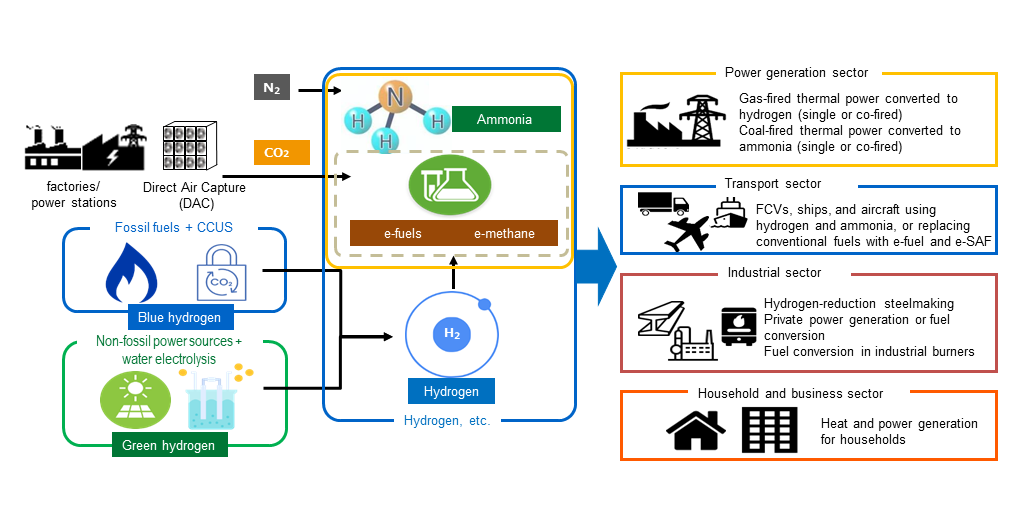
Additionally, we will advance the introduction of biofuels.
On the other hand, fossil fuels currently support a large portion of Japan’s energy supply. Based on this situation, our policy is to advance the energy transition while ensuring a stable supply. We will firmly continue efforts such as resource diplomacy, resource development at home and abroad, and the diversification of supply sources. Regarding LNG, the Plan encourages concerted efforts in the public and private sectors toward securing long-term contracts.
Other content in the Seventh Strategic Energy Plan includes CCUS, critical minerals, and energy system reform.
What will the energy situation be like in 2040 in terms of CO2 emissions reduction and the self-sufficiency ratio?
What will Japan’s energy situation be like in the future under the strategy shown in the Plan? Lastly, we will present the latest Outlook for Energy Supply and Demand in FY2040 (energy mix).
The energy self-sufficiency ratio in FY2023 was as low as 15.2% (preliminary figure). Renewables accounted for 22.9% of the total power source mix and nuclear power 8.5% thanks to the restart of nuclear power stations. However, thermal power still held the dominant share at 68.6%, which needs to be reduced to achieve decarbonization. (Figures are preliminary and subject to change.)
The FY2040 energy mix is projected on the basis of ambitious goals, such as a 73% reduction in GHG emissions in FY2040 (compared to FY2013) and achieving net zero by 2050.
Electricity generation is forecast to increase substantially in FY2040, reaching 1.1 to 1.2 trillion kWh, with the energy self-sufficiency ratio being 30 to 40%. Renewables will account for 40 to 50% of the total power source mix in FY2040, with nuclear power at 20% and thermal power at 30 to 40%.
Outlook for Energy Supply and Demand in FY2040
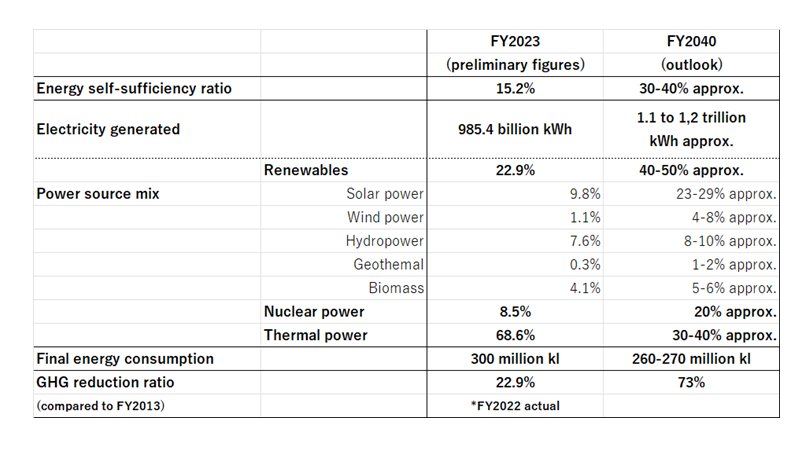
The government will begin by making realistic, consistent efforts to achieve the energy mix shown in the FY2030 Energy Mix. In doing so, we will implement all available measures ahead of 2030, such as improving energy efficiency, introducing renewable energy to the maximum extent possible, and restarting nuclear power stations once their safety is confirmed.
In addition, further technological innovation will be essential by 2040, although this will not be easy. We will make efforts to advance cutting-edge technologies, such as the introduction of perovskite solar cells and floating offshore wind turbines, the development and installation of next-generation advanced reactors, and the introduction of hydrogen, ammonia and CCUS, while observing the basic principle of Safety, Economic Efficiency, and the Environment (S+3E).
Furthermore, the Plan states that we will contribute to global initiatives for decarbonization. These include the Asia Zero Emission Community (AZEC), which aims to achieve decarbonization in Asia—a region where reliance on fossil fuels is high. To this end, we will make the most of the technologies in which Japan has prowess, such as energy efficiency improvements, renewable energy, and hydrogen/ammonia.
As various factors influence the energy situation in a complicated manner, it is necessary to formulate policies to simultaneously address diverse issues. We hope that this article on the detailed outline of the Strategic Energy Plan provides you with the opportunity to grasp the whole picture of Japan’s energy situation and gain some insights.
Visit here to read Part 1 of this article.
Divisions in Charge
About this article
Energy Strategy Office, Commissioner’s Secretariat, ANRE
About the Special Contents
Research and Public Relations Office, Commissioner’s Secretariat, ANRE
![]() The original Japanese text of this article; Click here
The original Japanese text of this article; Click here